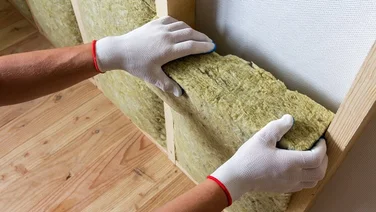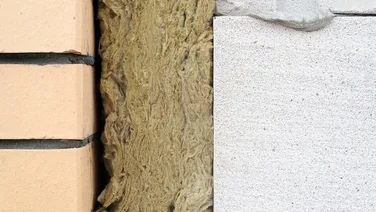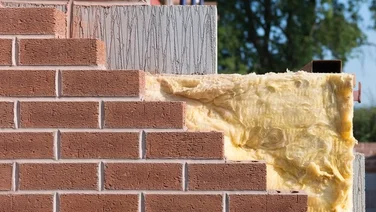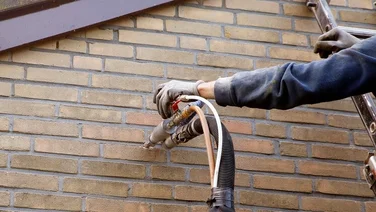- Plant-based materials is the greenest eco-friendly insulation
- Features like fire resistance and moisture resistance can vary between types
- Ultimately, the best option for you depends on your priorities
In the quest for a warmer, economical, and more sustainable home, choosing the right eco-friendly insulation can make all the difference – with some insulation costs being higher than others.
From cellulose and hemp to sheep’s wool, in this guide, we will be breaking down the best types of green insulation for your walls, attic, and floors to help you find the perfect fit for your home, lifestyle, and budget.
If you know which insulation material you want, we can help. Just share a few details and we’ll pop across some free quotes tailored to your needs.

What are the five best types of eco-friendly insulation?
Plant-based
Plant-based insulation materials, like hemp, wood fibre, cotton, cork, and straw, are becoming a popular choice for the eco-conscious homeowner.
By using sustainable plants, these insulations and their impressive thermal performance (otherwise known as R-value)* are a lot safer for you and the environment than traditional choices, keeping your home at a comfy temperature all year round.
A downside is that some plant materials, like cotton and wood, can be prone to moisture and rot, which can lead to dampness and mould. However, others like cork and hemp are breathable, which helps to regulate humidity levels and prevent condensation.
At around £15-£50 per square metre, depending on the material, plant-based insulation can be pricier upfront compared to fibreglass or foam options, but they often pay for themselves through energy savings over time.
*An R-value is a measure of how well a material can stop heat loss – the higher, the better for the best thermal effectiveness.
- Made from biodegradable resources with a low carbon footprint
- Free from harmful chemicals for better indoor air quality
- Good sound absorption properties
- More expensive than traditional insulation options
- May need additional treatments for fire resistance
- Some materials, if not treated, may attract pests or rodents

Sheep’s wool
As the name suggests, this insulation comes straight from the fleecy coats of our woolly friends – think of sheep’s wool insulation as nature’s cosy blanket for your home.
A standout feature is that it can absorb and release moisture without messing with its insulation, so you can say goodbye to mould and hello to a fresh home environment. The downside is that being a natural product, there’s a chance it won’t always be consistent in thickness and it can exacerbate some people’s allergies.
Cost-wise, this type of insulation is on the higher end of the spectrum at £18 to £25 per square metre, but the benefits justify the investment. With its sustainable sourcing and impressive R-value, many homeowners flock to sheep’s wool insulation.
- Renewable resource that can be sheared without causing harm
- Great for regulating humidity levels in your home, preventing mould and mildew
- Naturally fire-resistant, making it a safe choice for insulation
- More expensive than other insulation options
- Can entice pests unless it's treated
- Might be an irritant for some people with wool sensitivities
Recycled materials
Made primarily from post-consumer waste, like plastic bottles or newspapers, recycled material insulation is an innovative way of turning trash into treasure.
One standout benefit of this insulation type is that it makes use of materials that would otherwise end up in a landfill. Transforming recycled denim or paper into effective insulation that can snugly fit into walls, attics, or floors, gives tatty old jeans and yesterday’s news a fresh purpose and conserves the resources that would’ve gone into producing new insulation materials.
There are a few caveats. Recycled material insulation might not always offer the same fire resistance as traditional options, though retardant treatments can improve this. Plus, while it’s eco-friendly, it might not be as green as some natural insulations.
Still, for the eco-conscious homeowner, it’s a win-win situation for both their home and the environment. Price-wise, recycled material insulation, like cellulose, competes well with traditional options at £3-£11 per square metre, making it an appealing choice for keeping on top of insulation costs.
- Reduces the demand for new production and helps divert waste from landfills
- Often more affordable compared to other eco-friendly options
- Comes in various forms, such as loose-fill, rolls, or rigid boards, to suit different insulation needs
- Not all recycled materials have the same R-value, and some might not perform as well as top-tier insulations
- Materials like cellulose can compact over the years, reducing their insulation capability
- Some recycled materials might be more susceptible to moisture absorption, needing proper barriers or treatments to prevent mould growth
- Some types, especially paper-based cellulose, are inherently less fire-resistant
Glass wool (aka fibreglass)
Made from fine strands of glass woven into a texture similar to wool, fibreglass insulation, also known as glass wool, is that candy-floss-like material that’s often used as loft insulation, keeping the cold out and the cosy in.
At £4-£8 per metre square, fibreglass is a strong contender that’s been insulating homes for decades. This old favourite is often the go-to choice for many because of its affordability and wide availability.
Two of its major strengths are its excellent R-value and its non-flammability. However, installing fibreglass insulation requires care – those glass fibres can irritate your skin and lungs if you’re not wearing protective gear.
- One of the most cost-effective insulation options on the market
- Offers strong thermal insulation properties
- Glass is fire resistant, which helps enhance your home’s safety
- Has a long lifespan, providing consistent insulation over many years
- Can irritate the skin and lungs if handled improperly during installation
- Not the greatest at soundproofing compared to other insulation materials
- Prone to moisture damage if not properly installed and maintained
- Made from non-renewable resources and has a higher carbon footprint

Spray foam
Eco-friendly spray foam insulation is like the superhero of the insulation world, charging in to seal and insulate your home in one fell swoop. It’s made from a combination of non-toxic, renewable liquid materials that react and expand, creating a foam that can fill nooks, crannies, and hard-to-reach spaces with ease.
Spray foam costs are on the higher end of the spectrum, at between £20 to £50 per square metre, depending on the type and thickness of the insulation. But it’s often seen as a worthwhile investment because of its excellent insulating properties and potential energy savings. Check out our calculator to get an idea of the costs you might be looking at.
However, it’s important to leave the installation to the pros – it’s not a great DIY project because dodgy work can lead to off-gassing, and in extreme cases, respiratory issues.
- Creates an airtight seal that prevents air leakage and provides a superior R-value
- Versatile enough to be used in various areas of your home
- Acts as a moisture barrier, preventing condensation and allergens
- One of the more expensive insulation options upfront
- Needs professional installation and proper ventilation to avoid health issues
- Once you’ve applied spray foam, there are no takebacks – it’s challenging to remove, making future renovations or repairs more complicated
What’s the eco-friendly insulation material?
Choosing the best type of home insulation is a decision shaped by various factors, including your home’s setup, lifestyle choices, and budget.
For example, cellulose insulation, made from recycled paper, is a popular, cost-effective, and high-performance option. But if you’re leaning towards natural materials and have a higher budget, sheep’s wool or hemp insulation can be appealing options that offer excellent thermal properties and humidity regulation.
For those living in wetter climates, cork might be a great fit because of its natural resistance to moisture.
Ultimately, the ‘best’ choice is one that harmoniously blends all these factors into the perfect balance between environmental responsibility, comfort, and affordability.
Want to know more ways to have an eco-friendly home? Check out our guide to passive ventilation.
Summary
- Plant-based materials like wood fibre, hemp and straw are often considered the most environmentally friendly insulation
- Ultimately, the most eco-friendly option for you will depend on your circumstances and priorities
- The greenest insulation is typically cellulose, which is made from recycled paper products (usually old newspapers) treated to be fire and pest resistant
- To insulate your house naturally, consider using materials like wool, hemp or cotton (e.g. recycled denim). Cork, harvested from the bark of cork oak trees without harming them, is another sustainable and natural insulator
- Want to start by exploring spray foam insulation for your space? Request your free, personalised quotes by popping in your details here







